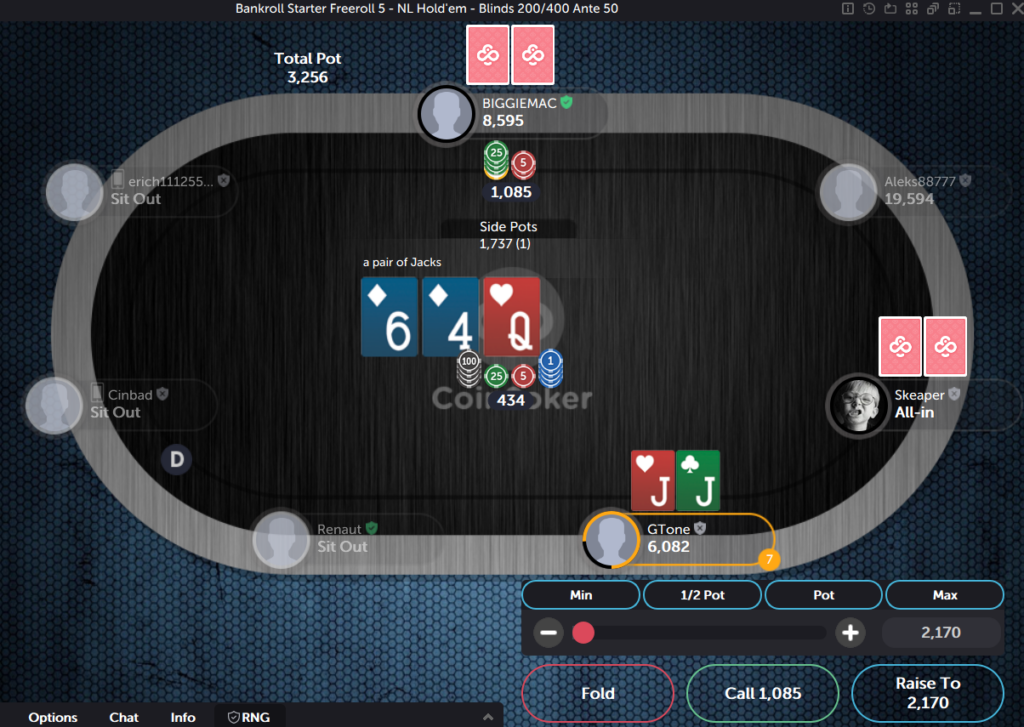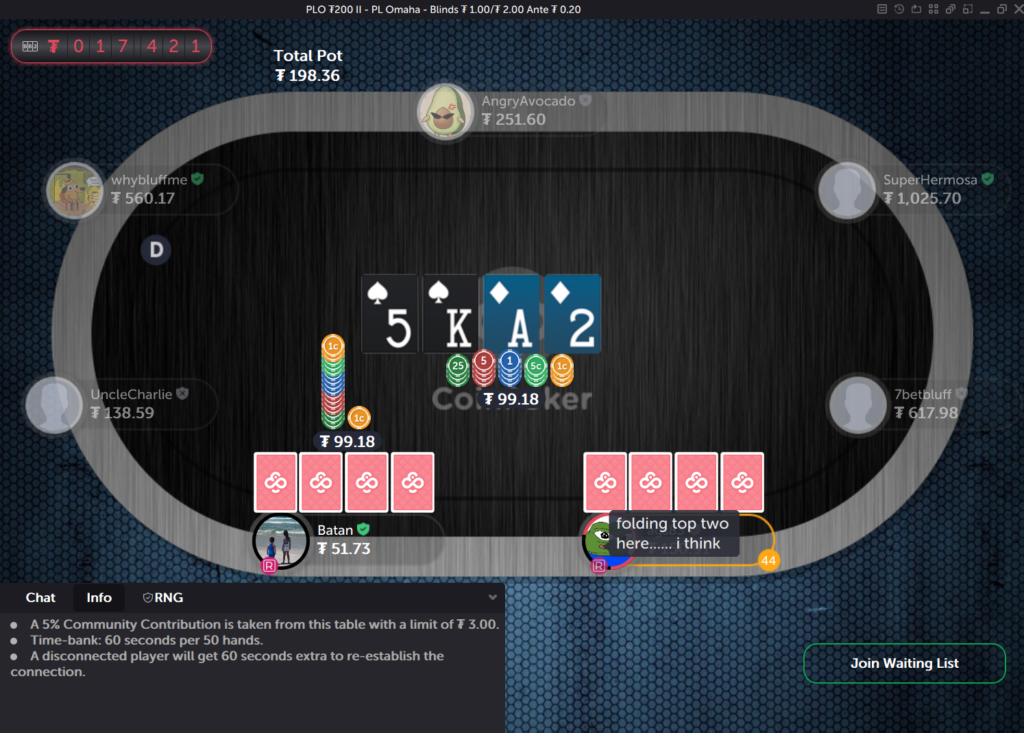Last Updated: 25 April 2025
MDF Poker: A Tool for Effective Defense Strategy
Using MDF poker, or minimum defense frequency, you’ll know which hands should call against high-level players. Learn about the concept in this guide.
StrategyEver find yourself staring at a big bet, wondering if you should make the hero call or just let it go? You’re not alone. Minimum Defense Frequency (MDF) in poker is like having a mathematical compass for these tricky situations. It’s not about guesswork or “feeling it in your gut” – it’s about knowing exactly how often you should be calling to keep your opponents honest.
At CoinPoker, we know that understanding MDF can transform your game from “I think I should call here” to “I know exactly what to do.” Let’s break down this powerful concept into something you can actually use at the tables.
What is MDF in Poker?
Think of minimum defense frequency (MDF) as your shield against aggressive players who love to throw chips around. It’s the minimum percentage of your hands you need to continue with (either calling or raising) when facing a bet to prevent your opponent from running you over with bluffs.
Here’s the simple truth: If an opponent knows you’re folding too much, they can print money by bluffing any two cards. Fold too rarely, and they’ll stop bluffing altogether, only betting when they have the goods. Your minimum defense frequency helps find that sweet spot in between.
MDF is particularly powerful on later streets, like the river, where decisions become more critical and expensive. Unlike many poker concepts that rely on feel or experience, MDF provides a concrete framework for making better defensive decisions. The beauty of MDF lies in its simplicity – once you understand the basic concept, you can apply it across virtually any poker situation.

Why MDF is Important to Your Game
Understanding MDF isn’t just about defense – it’s about building a profitable, sustainable poker strategy. Many players lose money not because they play their strong hands poorly, but because they either fold too much or call too much when facing aggression. MDF helps solve this problem by providing clear guidelines for how often you should be defending. This knowledge becomes increasingly valuable as you move up in stakes and face tougher opposition.
| Game Type | Stakes | MDF Importance | Key Considerations |
| Cash Games | Micro Stakes ($2-$10NL) | Low-Medium | – Most players aren’t balanced enough for strict MDF- Focus on exploitative play instead |
| Cash Games | Low-Mid Stakes ($25-$200NL) | Medium-High | – Players begin using more balanced strategies- MDF becomes increasingly relevant |
| Cash Games | High Stakes ($500NL+) | Very High | – Critical for surviving against strong regs- Must defend close to MDF to remain unexploitable |
| Heads-Up | All Stakes | Critical | – Most important in heads-up play- Frequent decisions against single opponent- Direct application of GTO principles |
| Game Type | Stakes | MDF Importance | Key Considerations |
| Tournaments | Low Buy-in (<$22) | Low | – Players tend to over-bluff or under-bluff- Adjust based on player tendencies |
| Tournaments | Mid Stakes ($22-$215) | Medium-High | – More balanced player pools- ICM considerations affect optimal defense frequency |
| Tournaments | High Stakes ($215+) | Very High | – Essential against sophisticated opponents- Must balance MDF with ICM considerations |
MDF becomes particularly important as you move up in stakes. While you might get away with over-folding in micro-stakes games where players rarely bluff enough, try that in higher stakes and you’ll quickly find yourself being bluffed out of every pot.
How to Use MDF Formula in Poker
Here’s where the math comes in – but don’t worry, it’s simpler than you might think. The basic MDF formula is:
MDF = Pot Size / (Pot Size + Bet Size)
Then multiply by 100 to get your percentage. Let’s break this down with some real examples.
MDF Example #1: The River Bet
You’re in a $1/$2 game with $100 in the pot. Your opponent bets $50. Should you call?
MDF = 100 / (100 + 50) = 0.67 or 67%
This means you need to continue with 67% of your range to prevent your opponent from profitably bluffing with any two cards. If you’re looking at your bottom pair wondering if it’s a call, ask yourself: “Is this hand in the top 67% of my range?”
MDF Example #2: The Overbet
Same pot size ($100), but this time your opponent goes for a big overbet of $200.
MDF = 100 / (100 + 200) = 0.33 or 33%
Notice how the larger bet size means you can fold more often? This is why overbets can be such powerful weapons – they force your opponent to make more folds.
MDF Example #3: The Small Bet
Now let’s look at a small bet. The pot is $100, and your opponent bets $25.
MDF = 100 / (100 + 25) = 0.80 or 80%
With such a small bet, you need to defend much more frequently. This is why min-betting as a bluff rarely works against good players – they can call with a wide range and still be mathematically correct.
When MDF Should Be Used
Think of MDF like a fancy sports car – powerful in the right conditions, but you wouldn’t use it for a grocery run. Here’s when to rev up your MDF engine:
- Against thinking opponents who adjust to your tendencies
- In higher stakes games where players are more balanced
- When facing unknown players without clear tendencies
- In spots where you have a lot of history with an opponent
- When playing against aggressive regulars who love to bluff
Just like we discuss in our Advanced Poker Strategies guide, MDF works best when your opponents are capable of both value betting and bluffing in a somewhat balanced way. It’s particularly useful in common spots like defending your big blind or facing river bets in position.

When MDF Should NOT Be Used
Just as important as knowing when to use MDF is knowing when to ignore it. Remember that poker is ultimately about making money, not about being unexploitable. Skip the MDF calculations when:
- Playing against recreational players who rarely bluff
- Facing opponents with obvious betting patterns
- In micro-stakes games where players are highly unbalanced
- When your opponent’s range is very strong or very weak
- In tournaments where ICM considerations override MDF
As we covered in our guide to poker variance, sometimes being “exploitable” is actually more profitable if your opponents aren’t good enough to exploit you. Also, consider skipping MDF calculations when you have strong reads on your opponent’s tendencies. If you know someone never bluffs rivers, for instance, you can safely fold more hands than MDF suggests. The key is to remain flexible and adapt your strategy based on your opponents.

Quick-Reference MDF Poker Chart
Using this chart is straightforward. Simply find the closest bet size in the left column that matches what you’re facing.
For example, if your opponent bets 70% of the pot, you can look at the 75% row and see you need to defend about 57% of your range. The “Must Defend With” column gives you a practical way to think about it – in this case, you should continue with the top 57% of your range.
Remember, your “top” hands aren’t just your strongest hands, but also hands that work well as bluff-catchers or have good playability in the specific situation.
| Defender | Aggressor | |||
| Value/bluff % construction | Pot Odds Required Equity to call | Value/bluff % construction | Alpha (a) Required fold equity when bluffing | Value / bluff % construction |
| 10% | 8% | 91% | 9% | 92% / 8% |
| 25% | 17% | 80% | 20% | 83% / 17% |
| 33% | 20% | 75% | 25% | 80% / 20% |
| 50% | 25% | 67% | 33% | 75% / 25% |
| 75% | 30% | 57% | 43% | 70% / 30% |
| 100% | 33% | 50% | 50% | 67% / 33% |
| 125% | 36% | 44% | 56% | 64% / 36% |
| 150% | 38% | %0t | 60% | 63% / 37% |
Pot Odds vs MDF: Which One to Use?
Think of pot odds and MDF as two different tools in your poker toolbox. Pot odds tell you whether calling is profitable with your specific hand, while MDF tells you how many hands you should be calling with total.
Here’s a quick comparison:
- Pot Odds
- Focused on individual hand profitability
- More important against straightforward players
- Easier to calculate in real-time
- Better for lower stakes games
- MDF
- Focused on overall range defense
- More important against skilled players
- Requires more complex calculations
- Better for higher stakes games
Against most players at lower stakes, focusing on pot odds will be more profitable. As you move up in stakes and face tougher opposition, MDF becomes increasingly important.
Understanding when to apply each concept is key. While pot odds help with individual decisions, MDF helps ensure your overall strategy remains profitable against thinking opponents who might try to exploit your tendencies.
Alpha: The Opposite of MDF in Poker
Alpha is the flip side of the MDF coin – it tells you how often you need your opponent to fold to make your bluffs profitable.
Understanding Alpha helps you make better bluffing decisions by showing you exactly how often your bluffs need to work. This is particularly valuable in spots where you’re considering turning a marginal hand into a bluff or sizing your bets to achieve optimal fold frequency.
The Formula for Calculating Alpha
Alpha = 1 – MDF
Simple, right? If the MDF is 67%, then Alpha is 33%. This means your opponent needs to fold at least 33% of the time for your bluff to be profitable.
Examples of Alpha in Poker Spots
The relationship between MDF and Alpha creates a perfect balance in poker strategy. When you know one, you automatically know the other. Let’s say you’re thinking about bluffing with a pot-sized bet. The Alpha would be 50%, meaning your opponent needs to fold at least half the time for your bluff to show an immediate profit. Is your opponent someone who likes to call down light? Maybe look for a better spot. Do they fold too much? Fire away!
Remember, just like with MDF, Alpha isn’t always the most important factor. Against players who never fold, even the most mathematically perfect bluff sizing won’t help you.
Consider another example: you’re thinking about bluffing into a side pot where you’d need to bet $300 to win $600. The Alpha here is 33%, meaning your opponent needs to fold one-third of the time for your bluff to be profitable. This kind of calculation becomes particularly valuable in tournament play, where stack depths and ICM considerations can significantly impact optimal bluffing frequencies.

The Best Ways to Practice MDF
Ready to put this knowledge into practice? Here’s how to get started:
- Start at suitable stakes where opponents are balanced enough for MDF to matter
- Use the quick reference chart during study sessions
- Practice calculating basic percentages away from the table
- Review hands where you faced tough river decisions
- Discuss spots with other players in study groups
Just like we discussed in our guide on becoming a professional player, improvement comes through structured practice and review. Consider using poker tracking software to identify spots where you’re consistently over-folding or over-calling. These patterns often indicate areas where applying MDF concepts could immediately improve your win rate.
Put Your MDF Knowledge to the Test
Join us at CoinPoker, where players of all skill levels come together to improve their game. From micro-stakes to high-stakes games, you’ll find the perfect environment to practice these concepts and take your poker game to the next level.
Remember, understanding MDF is just one piece of the puzzle. Combined with solid fundamentals, proper bankroll management, and good game selection, it can help you become a more complete and profitable player. See you at the tables!
FAQs
Divide the pot size by the total of pot size plus bet size.
MDF in low-stakes games matters less than in higher stakes, as players are often unbalanced.
No, adjust based on opponent tendencies and specific situations.
ICM considerations often make you fold more than MDF suggests.
Yes, but simplified calculations are recommended for practical use.
Explore More
Announcements
Read recent announcements from CoinPoker about new games, ambassadors, and changes to our platform.
8 PostsGuides
The go-to resource for mastering poker with expert tips and strategies. Whether you're a beginner or a pro, our guides will elevate your skill level.
60 PostsNews
Find the latest poker news from CoinPoker, plus our latest CoinPoker Weekly and Monthly Newsletters. Updates about games, promotions and other exciting crypto news.
90 PostsPromotions
Find the latest coinpoker promotions here. Explore the crypto poker world with the best poker promotions available.
1 Post
















